
The Danvers State Hospital, also known as the State Lunatic Hospital at Danvers, The Danvers Lunatic Asylum, and The Danvers State Insane Asylum, was a psychiatric hospital located in Danvers, Massachusetts. It was built in 1874, and opened in 1878, under the supervision of prominent Boston architect Nathaniel Jeremiah Bradlee, on an isolated site in rural Massachusetts. It was a multi-acre, self-contained psychiatric hospital designed and built according to the Kirkbride Plan.
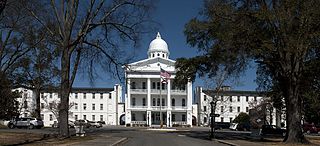
Bryce Hospital opened in 1861 in Tuscaloosa, Alabama, United States. It is Alabama's oldest and largest inpatient psychiatric facility. First known as the Alabama State Hospital for the Insane and later as the Alabama Insane Hospital, the building is considered an architectural model. The hospital houses 268 beds for acute care, treatment and rehabilitation of full-time (committed) patients. The Mary Starke Harper Geriatric Psychiatry Hospital, a separate facility on the same campus, provides an additional 100 beds for inpatient geriatric care. The main facility was added to the National Register of Historic Places in 1977.

Logansport State Hospital is a psychiatric hospital located in Logansport, Indiana, United States.
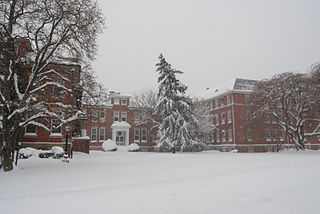
The Crownsville Hospital Center was a psychiatric hospital located in Crownsville, Maryland. It was in operation from 1911 until 2004.

Oregon State Hospital is a public psychiatric hospital in the U.S. state of Oregon, located in the state's capital city of Salem with a smaller satellite campus in Junction City opened in 2014. Founded in 1862 and constructed in the Kirkbride Plan design in 1883, it is the oldest operating psychiatric hospital in the state of Oregon, and one of the oldest continuously operated hospitals on the West Coast.

The Institute of Pennsylvania Hospital, also known as Kirkbride's Hospital or the Pennsylvania Hospital for Mental and Nervous Diseases, was a psychiatric hospital located at 48th and Haverford Streets in Philadelphia, Pennsylvania, USA. It operated from its founding in 1841 until 1997. The remaining building, now called the Kirkbride Center is now part of the Blackwell Human Services Campus.

The Indiana Medical History Museum is an Indianapolis monument to the beginning of psychiatric medical research. It is located on the grounds of what was formerly Central Indiana Hospital for the Insane, later shortened to Central State Hospital. It was placed on the National Register of Historic Places on April 25, 1972, as the Old Pathology Building.
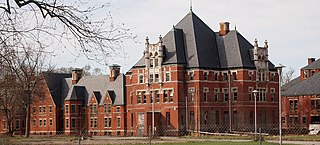
The Norwich State Hospital, originally established as Norwich State Hospital for the Insane and later shortened to Norwich Hospital, is a former psychiatric hospital that is located in Preston and Norwich, Connecticut. It opened its doors in October 1904 and operated until October 10, 1996. Throughout its years of operation, it housed geriatric patients, chemically dependent patients and, from 1931 to 1939, tubercular patients. The hospital, which sits on the banks of the Thames River, began with a single building on 100 acres (40 ha) of land and expanded to, at its peak, over thirty buildings and 900 acres (360 ha).
Mendota Mental Health Institute (MMHI) is a public psychiatric hospital in Madison, Wisconsin, United States, operated by the Wisconsin Department of Health Services. The hospital is accredited by the Joint Commission. Portions of the facility are included in the Wisconsin Memorial Hospital Historic District, District #88002183. The Mendota State Hospital Mound Group and Farwell's Point Mound Group are also located at the facility.
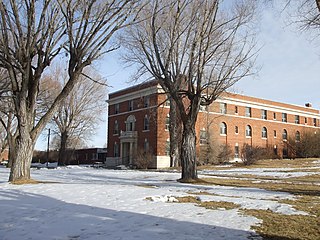
Asylum architecture in the United States, including the architecture of psychiatric hospitals, affected the changing methods of treating the mentally ill in the nineteenth century: the architecture was considered part of the cure. Doctors believed that ninety percent of insanity cases were curable, but only if treated outside the home, in large-scale buildings. Nineteenth-century psychiatrists considered the architecture of asylums, especially their planning, to be one of the most powerful tools for the treatment of the insane, targeting social as well as biological factors to facilitate the treatment of mental illnesses. The construction and usage of these quasi-public buildings served to legitimize developing ideas in psychiatry. About 300 psychiatric hospitals, known at the time as insane asylums or colloquially as “loony bins” or “nuthouses,” were constructed in the United States before 1900. Asylum architecture is notable for the way similar floor plans were built in a wide range of architectural styles.

Matteawan State Hospital for the Criminally Insane, established in 1892 as the Matteawan State Hospital by an 1892 law, functioned as a hospital for insane criminals. It was located in the town of Fishkill just outside the city of Beacon, New York; today its buildings form part of Fishkill Correctional Facility.

Eastern State Hospital is a psychiatric hospital established in 1891 in Medical Lake, a small community 20 miles (32 km) southwest of Spokane, Washington. The original building was a Kirkbride Plan and the current building has a similar floor plan with male and female wings extending out from the main building.
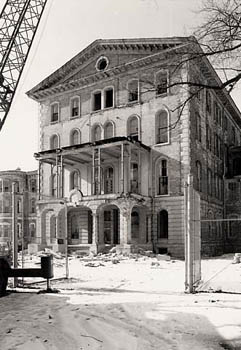
The Elgin Mental Health Center is a mental health facility operated by the State of Illinois in Elgin, Illinois. Throughout its history, Elgin's mission has changed. At times, it treated mental illness, tuberculosis, and provided federally funded care for veterans. The hospital's site, which included a patient-staffed farm reached a maximum of 1,139 acres (461 ha) after World War II. Its maximum population was reached in the mid 1950s with 7,700 patients. Between 1993 and 2008, most of the older buildings in the complex were demolished due to being in poor condition as the result of being abandoned for decades. The site is/was popular among teens and in the paranormal world due to its claims of hauntings in the older buildings and the hospital's cemetery.
The Jacksonville Developmental Center was an institution for developmentally delayed clients, located in Jacksonville, Illinois. It was open from 1851 to November 2012. As of December 2012, the 134-acre (54 ha) grounds was still owned by the State of Illinois.

The Utah State Hospital (USH) is a mental hospital located in eastern Provo, Utah. The current superintendent is Dallas Earnshaw.
Middletown State Homeopathic Hospital was a hospital for the treatment of mental disorders located in Middletown, New York. It opened on April 20, 1874, and was the first purely homeopathic hospital for mental disorders in the United States. The hospital, which served "mentally ill patients from Orange, Sullivan and Ulster Counties". employed a number of new techniques for the treatment of mental disorders, most notably the use of baseball as a therapy.

Luther Vose Bell, M.D. was one of the thirteen mental hospital superintendents who met in Philadelphia in 1844 to organize the Association of Medical Superintendents of American Institutions for the Insane (AMSAII), now the American Psychiatric Association, and the first medical specialty society in the United States. He was also Superintendent of the McLean Asylum near Boston, from 1837 to 1855.
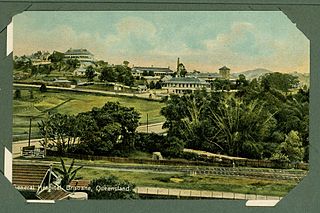
Brisbane General Hospital Precinct is a heritage-listed hospital precinct at 40 Bowen Bridge Road, Herston, City of Brisbane, Queensland, Australia. It was built from 1875 to 1941. It includes six historic buildings associated with the Royal Brisbane and Women's Hospital and the former Royal Children's Hospital, as well as aspects of their grounds and landscaping. It was added to the Queensland Heritage Register on 28 March 2003. A number of buildings in the precinct, in particular the Lady Lamington Nurses Home, will be redeveloped as part of the Herston Quarter development.

The Maine Insane Hospital, later the Augusta Mental Health Institute (AMHI), was a psychiatric hospital in Augusta, Maine. It was the principal facility for the care and treatment of Maine's mentally ill from 1840 to 2004, and its surviving buildings represent the oldest surviving complex of mental care facilities in the United States. The complex is located on the east bank of the Kennebec River, immediately south of the former Kennebec Arsenal, and now primarily houses state offices. In 2004, the hospital was replaced by the Riverview Psychiatric Center, located just to the south. The hospital's core complex was listed on the National Register of Historic Places in 1982, with the listing enlarged to encompass the entire campus in 2001.

The John G. Kerr Refuge for the Insane was founded by the Presbyterian medical missionary, John Glasgow Kerr in Canton, China in 1898. The hospital was the first facility in China dedicated towards the treatment of mental illness, and was expanded up to 500 beds, operating until 1937.





















